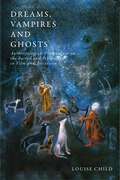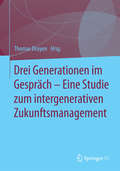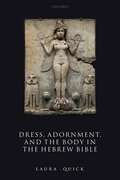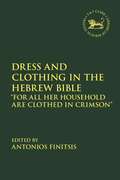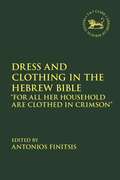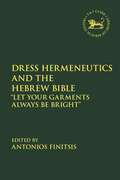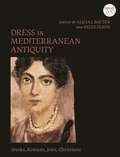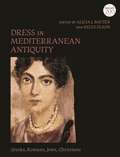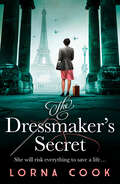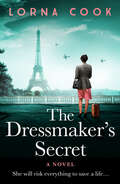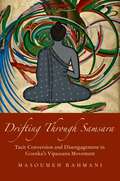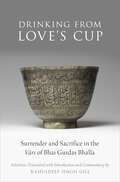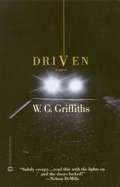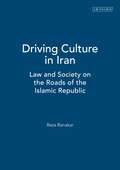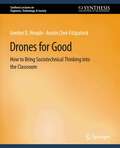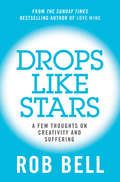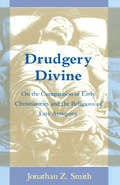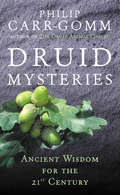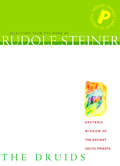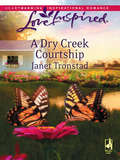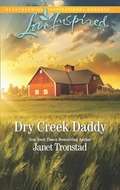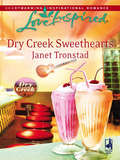- Table View
- List View
Dreams, Vampires and Ghosts: Anthropological Perspectives on the Sacred and Psychology in Film and Television
by Louise ChildDrawing from social theory and the anthropology of religion, this book explores popular media's fascination with dreams, vampires, demons, ghosts and spirits. Dreams, Vampires and Ghosts does so in the light of contemporary animist studies of societies in which other-than-human persons are not merely a source of entertainment, but a lived social reality. Films and television programs explored include Buffy the Vampire Slayer, Twin Peaks, Bram Stoker's Dracula, Truly Madly Deeply and the films of Hitchcock. Louise Child draws attention to how they both depict and challenge ideas and practices rooted in psychology, while quality television has also facilitated a wave of programming that can explore the interaction of characters in complex social worlds over time. In addition to drawing on theories of film from Freudian psychology and feminist theory, Dreams, Vampires and Ghosts uses approaches derived from a combination of Jungian film studies and anthropology that offer fresh insights for exploring film and television. This book draws attention to explicit and subtle ways in which cinematic narratives engage with myth and religion while at the same time exploring collective dimensions to social and personal life. It advances new developments in genre studies and gender as well as contributing to the growing field of implicit religion using in-depth analyses of communicative dreaming, the shadow, and mystical lovers in film and television.
Drei Generationen im Gespräch – Eine Studie zum intergenerativen Zukunftsmanagement
by Thomas DruyenIm Rahmen der Vermögensforschung haben sich neben den Themen des Reichtums auch das Vermögen des Alters, der Generationen und der Gesundheit als wesentliche Perspektiven herausgestellt. Diese Potenziale sind zugleich wesentlich in der Gestaltung der aktuellen demografischen Veränderungsprozesse. Wissenschaftliche Erkenntnisse zur Dringlichkeit finanzieller, gesundheitlicher und biografischer Vorsorge liegen vor – sie finden jedoch bei den Betroffenen kaum handlungsleitenden Niederschlag. Die vorliegende Studie untersucht anhand intergenerativer Befragungen Perspektiven und Verdrängungsmechanismen in Bezug auf die Zukunftsgestaltung. Mit der gestiegenen Lebenserwartung hat sich die vor jedem liegende Zukunft signifikant verlängert. Umso größer sind die Optionen – und die Notwendigkeit – der vorsorgenden Einwirkung. Dieses Verständnis soll mit der vorliegenden Arbeit befördert werden.
Dress, Adornment, and the Body in the Hebrew Bible
by Laura QuickDress, Adornment, and the Body in the Hebrew Bible is the first monograph to treat dress and adornment in biblical literature in the English language. It moves beyond a description of these aspects of ancient life to encompass notions of interpersonal relationships and personhood that underpin practices of dress and adornment. Laura Quick explores the ramifications of body adornment in the biblical world, informed by a methodologically plural approach incorporating material culture alongside philology, textual exegesis, comparative evidence, and sociological models. Drawing upon and synthesizing insights from material culture and texts from across the eastern Mediterranean, the volume reconstructs the social meanings attached to the dressed body in biblical texts. It shows how body adornment can deepen understanding of attitudes towards the self in the ancient world. In Quick's reconstruction of ancient performances of the self, the body serves as the observed centre in which complex ideologies of identity, gender, sexuality, ethnicity, and social status are articulated. The adornment of the body is thus an effective means of non-verbal communication, but one which at the same time is controlled by and dictated through normative social values. Exploring dress, adornment, and the body can therefore open up hitherto unexplored perspectives on these social values in the ancient world, an essential missing piece in understanding the social and cultural world which shaped the Hebrew Bible.
Dress, Adornment, and the Body in the Hebrew Bible
by Laura QuickDress, Adornment, and the Body in the Hebrew Bible is the first monograph to treat dress and adornment in biblical literature in the English language. It moves beyond a description of these aspects of ancient life to encompass notions of interpersonal relationships and personhood that underpin practices of dress and adornment. Laura Quick explores the ramifications of body adornment in the biblical world, informed by a methodologically plural approach incorporating material culture alongside philology, textual exegesis, comparative evidence, and sociological models. Drawing upon and synthesizing insights from material culture and texts from across the eastern Mediterranean, the volume reconstructs the social meanings attached to the dressed body in biblical texts. It shows how body adornment can deepen understanding of attitudes towards the self in the ancient world. In Quick's reconstruction of ancient performances of the self, the body serves as the observed centre in which complex ideologies of identity, gender, sexuality, ethnicity, and social status are articulated. The adornment of the body is thus an effective means of non-verbal communication, but one which at the same time is controlled by and dictated through normative social values. Exploring dress, adornment, and the body can therefore open up hitherto unexplored perspectives on these social values in the ancient world, an essential missing piece in understanding the social and cultural world which shaped the Hebrew Bible.
Dress and Clothing in the Hebrew Bible: “For All Her Household Are Clothed in Crimson” (The Library of Hebrew Bible/Old Testament Studies #679)
by Antonios FinitsisBuilt upon the flourishing study of costume, this book analyses sartorial evidence provided both by texts of the ancient Near East and the Hebrew Bible. The essays within lend clarity to the link between material and ideological, examining the tradition of dress, the different types of literature that reference the tradition of garments, and the people for whom such literature was written. The contributors explore sources that illuminate the social, psychological, aesthetic, ideological and symbolic meanings of clothing. The topics covered range from the relationship between clothing, kingship and power, to the symbolic significance of the high priestly regalia and the concept of garments as deception and defiance, while also considering the tendency to omit or ignore descriptions of YHWH's clothing. Following a historical sequence, the essays cross-reference with each other to create a milestone in biblical sartorial study.
Dress and Clothing in the Hebrew Bible: “For All Her Household Are Clothed in Crimson” (The Library of Hebrew Bible/Old Testament Studies)
Built upon the flourishing study of costume, this book analyses sartorial evidence provided both by texts of the ancient Near East and the Hebrew Bible. The essays within lend clarity to the link between material and ideological, examining the tradition of dress, the different types of literature that reference the tradition of garments, and the people for whom such literature was written. The contributors explore sources that illuminate the social, psychological, aesthetic, ideological and symbolic meanings of clothing. The topics covered range from the relationship between clothing, kingship and power, to the symbolic significance of the high priestly regalia and the concept of garments as deception and defiance, while also considering the tendency to omit or ignore descriptions of YHWH's clothing. Following a historical sequence, the essays cross-reference with each other to create a milestone in biblical sartorial study.
Dress Hermeneutics and the Hebrew Bible: "Let Your Garments Always Be Bright" (The Library of Hebrew Bible/Old Testament Studies)
Antonios Finitsis and contributors continue their examination of dress and clothing in the Hebrew Bible in this collection of illuminating essays. Straddling the divide between the material and the ideological, this book lends shape and texture to topics including social standing, agency, and the motif of cloth and clothing in Esther. Essays also explore the function of dress metaphors in imprecatory Psalms, the symbolic function of headdresses, and the divine clothing of Adam and Eve and the hermeneutics of trauma recovery. Together, the contributors continue to shape scholarly discourse on a growing body of scholarship on dress in the Bible.By turning their analytical gaze to this primary evidence, the contributors are able to reveal the social, psychological, aesthetic, ideological and symbolic meanings of dress in the Hebrew Bible, thereby producing insights into the literature and cultural world of the ancient Near East.
Dress in Mediterranean Antiquity: Greeks, Romans, Jews, Christians
by Alicia J. Batten and Kelly OlsonInsights from anthropology, religious studies, biblical studies, sociology, classics, and Jewish studies are here combined to provide a cutting-edge guide to dress and religion in the Greco-Roman World and the Mediterranean basin. Clothing, jewellery, cosmetics, and hairstyles are among the many aspects examined to show the variety of functions of dress in communication and in both establishing and defending identity. The volume begins by reviewing how scholars in the fields of classics, anthropology, religious studies, and sociology examine dress. The second section then looks at materials, including depictions of clothing in sculpture and in Egyptian mummy portraits. The third (and largest) part of the book then examines dress in specific contexts, beginning with Greece and Rome and going on to Jewish and Christian dress, with a specific focus on the intersection between dress, clothing and religion. By combining essays from over twenty scholars from different disciplinary backgrounds, the book provides a unique overview of different approaches to and contexts of dress in one volume, leading to a greater understanding of dress both within ancient societies and in the contemporary world.
Dress in Mediterranean Antiquity: Greeks, Romans, Jews, Christians
by Alicia J. Batten Kelly OlsonInsights from anthropology, religious studies, biblical studies, sociology, classics, and Jewish studies are here combined to provide a cutting-edge guide to dress and religion in the Greco-Roman World and the Mediterranean basin. Clothing, jewellery, cosmetics, and hairstyles are among the many aspects examined to show the variety of functions of dress in communication and in both establishing and defending identity. The volume begins by reviewing how scholars in the fields of classics, anthropology, religious studies, and sociology examine dress. The second section then looks at materials, including depictions of clothing in sculpture and in Egyptian mummy portraits. The third (and largest) part of the book then examines dress in specific contexts, beginning with Greece and Rome and going on to Jewish and Christian dress, with a specific focus on the intersection between dress, clothing and religion. By combining essays from over twenty scholars from different disciplinary backgrounds, the book provides a unique overview of different approaches to and contexts of dress in one volume, leading to a greater understanding of dress both within ancient societies and in the contemporary world.
The Dressmaker’s Secret
by Lorna Cook‘Extraordinary… Brought history alive on the page… Tense and emotional… Sensitive yet brutal…With the most unexpected end that left me breathless. Wow, just wow… Incredible’ NetGalley Review, ⭐⭐⭐⭐⭐ 1941, Nazi-occupied Paris: In the glamourous Ritz hotel there is a woman with a dangerous secret…
The Dressmaker’s Secret
by Lorna Cook‘Extraordinary… Brought history alive on the page… Tense and emotional… Sensitive yet brutal…With the most unexpected end that left me breathless. Wow, just wow… Incredible’ NetGalley Review, ⭐⭐⭐⭐⭐ 1941, Nazi-occupied Paris: In the glamourous Ritz hotel there is a woman with a dangerous secret…
Drifting through Samsara: Tacit Conversion and Disengagement in Goenka's Vipassana Movement (AAR Academy Series)
by Masoumeh RahmaniIn Drifting Through Samsara, Masoumeh Rahmani provides a fieldwork-based study of Goenka's Vipassana meditation movement in New Zealand. This group is distinguished by its refusal to identify as Buddhist and by a rich rhetorical repertoire for repackaging Theravada Buddhist teachings in pseudo-scientific and secular language. Drawing from qualitative research, the book examines the way the movement's discourse shapes unique processes and narratives of conversion and disengagement. Rahmani argues that conversion to this movement is tacit and paradoxically results in the members' rejection of religious labels and categories including conversion. Tracing the linguistic changes associated with the process of conversion and increased commitment, she outlines three main disengagement pathways: (1) pragmatic leaving, (2) disaffiliation, and (3) deconversion. Pragmatic leavers are individuals who were disengaged prior to developing a commitment. Rahmani argues that the language of these leavers is characterised by pragmatisms, dualistic discourse, and ambivalence, and their post-disengagement involves an active gravitation towards practices with easily accomplished goals. Disaffiliates and deconverts are individuals who disengaged after years of intense commitment to the movement. One of the distinguishing features of disaffiliation narratives is self-doubt resulting from the movement's ambiguous discourse regarding progress. For these people post-disengagement often involves the retrospective adoption of Buddhist identity. Rahmani finds that as a consequence of its linguistic strategies, deconversion is a rare exit pattern from this movement. In general, however, the themes and characteristics of both disaffiliation and deconversion fit the contours of exit from other traditions, even though conversion was tacit in the first place. The book thus questions the normative participant recruitment approach in conversion studies and argues that a simple reliance on the informants' identification with or rejection of religious labels fails to encompass the tonalities of conversion in the contemporary spiritual landscape.
Drifting through Samsara: Tacit Conversion and Disengagement in Goenka's Vipassana Movement (AAR Academy Series)
by Masoumeh RahmaniIn Drifting Through Samsara, Masoumeh Rahmani provides a fieldwork-based study of Goenka's Vipassana meditation movement in New Zealand. This group is distinguished by its refusal to identify as Buddhist and by a rich rhetorical repertoire for repackaging Theravada Buddhist teachings in pseudo-scientific and secular language. Drawing from qualitative research, the book examines the way the movement's discourse shapes unique processes and narratives of conversion and disengagement. Rahmani argues that conversion to this movement is tacit and paradoxically results in the members' rejection of religious labels and categories including conversion. Tracing the linguistic changes associated with the process of conversion and increased commitment, she outlines three main disengagement pathways: (1) pragmatic leaving, (2) disaffiliation, and (3) deconversion. Pragmatic leavers are individuals who were disengaged prior to developing a commitment. Rahmani argues that the language of these leavers is characterised by pragmatisms, dualistic discourse, and ambivalence, and their post-disengagement involves an active gravitation towards practices with easily accomplished goals. Disaffiliates and deconverts are individuals who disengaged after years of intense commitment to the movement. One of the distinguishing features of disaffiliation narratives is self-doubt resulting from the movement's ambiguous discourse regarding progress. For these people post-disengagement often involves the retrospective adoption of Buddhist identity. Rahmani finds that as a consequence of its linguistic strategies, deconversion is a rare exit pattern from this movement. In general, however, the themes and characteristics of both disaffiliation and deconversion fit the contours of exit from other traditions, even though conversion was tacit in the first place. The book thus questions the normative participant recruitment approach in conversion studies and argues that a simple reliance on the informants' identification with or rejection of religious labels fails to encompass the tonalities of conversion in the contemporary spiritual landscape.
Drinking From Love's Cup: Surrender and Sacrifice in the V=ars of Bhai Gurdas Bhalla (AAR Religion in Translation)
by Rahuldeep Singh GillBhai Gurdas Bhalla (d. 1636 CE) is widely considered the most important non-canonical poet in Sikh history, having shaped the theology and ethics of the tradition for centuries. His poems, which offer an authoritative illustration of Sikh life in the early seventeenth century, defined Sikh identity during a tumultuous period of upheaval. In Drinking from Love's Cup, Rahuldeep Gill brings together for the first time a collection of the revered poet's early work, masterfully translated into English, alongside the original Punjabi text. The magic of Gurdas's poetry, says Gill, is the fusion of Islamicate narrative with Indian heroic literature to speak about death, martyrdom, and the spirit's absolution in love. Gill challenges the traditional scholarship surrounding the dates of Gurdas's writing, suggesting that Gurdas wrote his poetry to console the Sikh community when it was in mourning over the execution of the fifth of the Sikh founders, Guru Arjan (d.1606), by agents of the Mughal Empire. Gurdas in his verses immortalized the fifth Guru's role as a martyr and encouraged the faithful to stay involved in the community, resist hegemony, and reinforce Sikh beliefs during the sectarian upheaval. Rhythmic, elegant, and lucid, the poems weave Sikh scripture into the lyrical fabric of Sikh spirituality. Gill brings a contemporary flair to Gurdas's moving stanzas and in his commentary unearths fresh insights about his life and context.
Drinking From Love's Cup: Surrender and Sacrifice in the V=ars of Bhai Gurdas Bhalla (AAR Religion in Translation)
by Rahuldeep Singh GillBhai Gurdas Bhalla (d. 1636 CE) is widely considered the most important non-canonical poet in Sikh history, having shaped the theology and ethics of the tradition for centuries. His poems, which offer an authoritative illustration of Sikh life in the early seventeenth century, defined Sikh identity during a tumultuous period of upheaval. In Drinking from Love's Cup, Rahuldeep Gill brings together for the first time a collection of the revered poet's early work, masterfully translated into English, alongside the original Punjabi text. The magic of Gurdas's poetry, says Gill, is the fusion of Islamicate narrative with Indian heroic literature to speak about death, martyrdom, and the spirit's absolution in love. Gill challenges the traditional scholarship surrounding the dates of Gurdas's writing, suggesting that Gurdas wrote his poetry to console the Sikh community when it was in mourning over the execution of the fifth of the Sikh founders, Guru Arjan (d.1606), by agents of the Mughal Empire. Gurdas in his verses immortalized the fifth Guru's role as a martyr and encouraged the faithful to stay involved in the community, resist hegemony, and reinforce Sikh beliefs during the sectarian upheaval. Rhythmic, elegant, and lucid, the poems weave Sikh scripture into the lyrical fabric of Sikh spirituality. Gill brings a contemporary flair to Gurdas's moving stanzas and in his commentary unearths fresh insights about his life and context.
Driven
by W. G. GriffithsGavin Pierce, a homicide detective with the Nassau County Police Department on Long Island, is in hot pursuit of a serial killer. As Pierce's hunt for the unconventional maniac progresses, there is no shortage of clues, evidence...or victims. All of which point to a predator whose expertise is matched only by an unnerving ability to escape capture. With this exciting and spiritual thriller in the vein of Frank Peretti, W.G. Griffiths offers up a chilling tale of one man's desperate fight against an evil that is darker and more violent than any he has encountered before. And when the final curtain is at last raised on this paranormal drama -- the hunter finds himself the hunted.
Driving Culture in Iran: Law and Society on the Roads of the Islamic Republic (International Library of Iranian Studies)
by Reza BanakarReza Banakar is Professor and Director of Research in the Sociology of Law Department at Lund University. He has previously held the positions of Professor of Socio-Legal Studies at the Department of Advanced Legal Studies at the University of Westminster and Research Fellow at the Centre for Socio-Legal Studies at the University of Oxford. He is the author of Normativity in Legal Sociology (2015) and Law and Social Theory (2010, 2013).
Drones for Good: How to Bring Sociotechnical Thinking into the Classroom (Synthesis Lectures on Engineers, Technology, & Society)
by Gordon D. Hoople Austin Choi-FitzpatrickWhat in the world is a social scientist doing collaborating with an engineer, and an engineer with a sociologist, and together on a book about drones and sociotechnical thinking in the classroom? This book emerges from a frustration that disciplinary silos create few opportunities for students to engage with others beyond their chosen major. In this volume, Hoople and Choi-Fitzpatrick introduce a sociotechnical approach to truly interdisciplinary education around the exciting topic of drones. The text, geared primarily at university faculty, provides a hands-on approach for engaging students in challenging conversations at the intersection of technology and society. Choi-Fitzpatrick and Hoople provide a turnkey solution complete with detailed lesson plans, course assignments, and drone-based case studies. They present a modular framework, describing how faculty might adopt their approach for any number of technologies and class configurations.
Drops Like Stars: A Few Thoughts On Creativity And Suffering (G - Reference, Information And Interdisciplinary Subjects Ser.)
by Rob BellRob Bell’s extraordinary and provocative Drops Like Stars, published as part of the Rob Bell Classics relaunch, explores the relationship between suffering and creativity, and the transformative power of pain.
Drudgery Divine: On the Comparison of Early Christianities and the Religions of Late Antiquity (Chicago Studies in the History of Judaism)
by Jonathan Z. SmithIn this major theoretical and methodological statement on the history of religions, Jonathan Z. Smith shows how convert apologetic agendas can dictate the course of comparative religious studies. As his example, Smith reviews four centuries of scholarship comparing early Christianities with religions of late Antiquity (especially the so-called mystery cults) and shows how this scholarship has been based upon an underlying Protestant-Catholic polemic. The result is a devastating critique of traditional New Testament scholarship, a redescription of early Christianities as religious traditions amenable to comparison, and a milestone in Smith's controversial approach to comparative religious studies. "An important book, and certainly one of the most significant in the career of Jonathan Z. Smith, whom one may venture to call the greatest pathologist in the history of religions. As in many precedent cases, Smith follows a standard procedure: he carefully selects his victim, and then dissects with artistic finesse and unequaled acumen. The operation is always necessary, and a deconstructor of Smith's caliber is hard to find."—Ioan P. Coulianu, Journal of Religion
Druid Mysteries: Ancient Wisdom for the 21st Century
by Philip Carr-GommIn this beautifully-written guide, Chief Druid Philip Carr-Gomm shows how the way of Druids can be followed today. He explains- The ancient history and inspiring beliefs of the ancient Druids- Druidic wild wisdom and their tree-, animal- and herb-lore- The mysteries of the Druids' seasonal celebrations- The Druids' use of magic and how their spirituality relates to paths such as WiccaThis guide will show how the wild wisdom of the Druids can help us to connect with our spirituality, our innate creativity, the natural world and our sense of ancestry. The life-enhancing beliefs and practices of this spiritual path have much to offer our 21st-century world.
The Druids: Esoteric Wisdom of the Ancient Celtic Priests (Pocket Library Of Spiritual Wisdom)
by Rudolf SteinerThe Sun Initiation of the Druid Priests and their Moon Science; The Mysteries of Ancient Ireland; Celtic Christianity - the Heritage of the Druids; Teachings of the Mysteries - the Spirit in Nature; The Great Mysteries - the Mystery of Christ; The Function of the Standing Stones; Spiritual Imaginations.
A Dry Creek Courtship (Dry Creek #11)
by Janet TronstadCharley Nelson wants a change. He wants more than just breakfast and banter with longtime friend Edith Hargrove. Charley wants, well… he wants romance. Somehow, Mrs. Hargrove has gotten under his skin and into his heart.
Dry Creek Daddy: Runaway Amish Bride Dry Creek Daddy A Baby For The Minister (Dry Creek #18)
by Janet TronstadHe never knew he had a son…
Dry Creek Sweethearts: Her Secret Amish Child Easter In Dry Creek Wildfire Sweethearts (Dry Creek #10)
by Janet TronstadBack From The Big Time… She could scarcely believe her eyes. An enormous tour bus had arrived in Dry Creek, and from it stepped hometown hero Duane Enger, now a music celebrity. Linda Morgan, owner of the local café, had thought her ex-boyfriend had become too famous for the small-town life she loved. But something had pulled Duane back.
